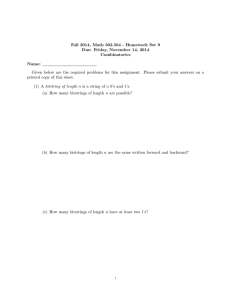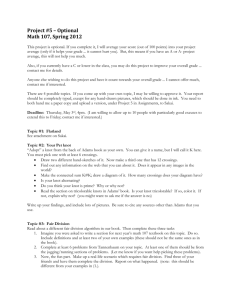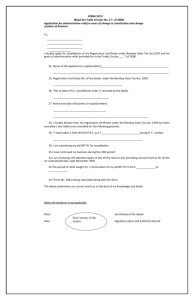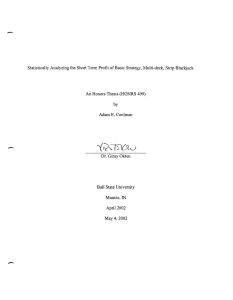A Derivation of Basic Strategy for Blackjack
advertisement
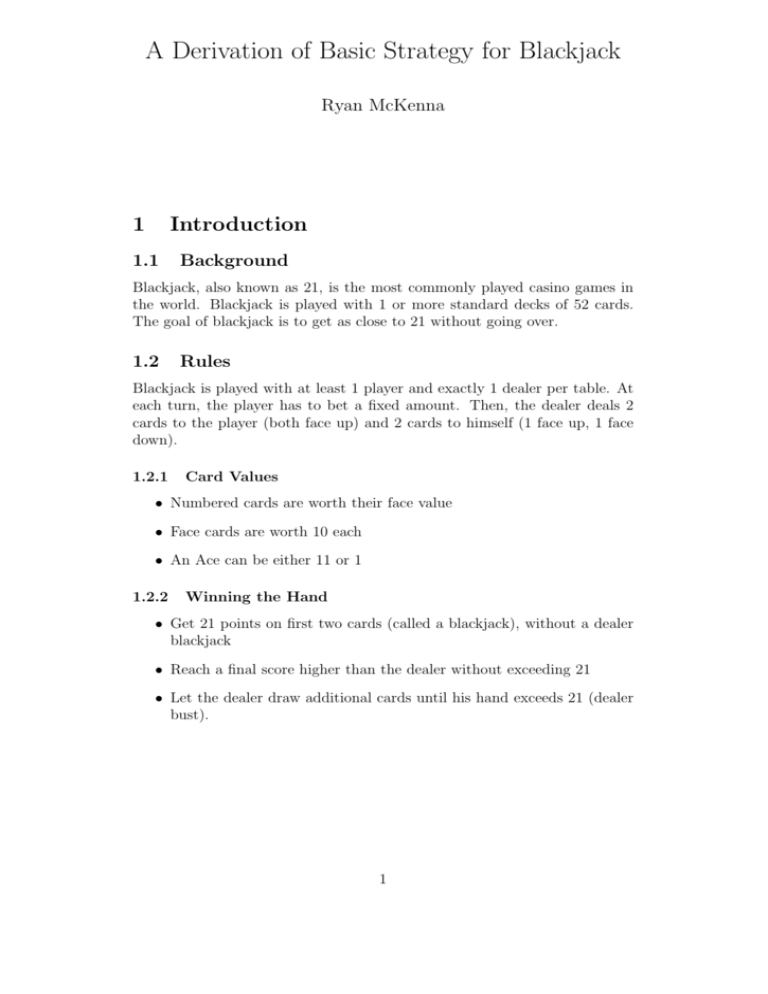
A Derivation of Basic Strategy for Blackjack
Ryan McKenna
1
Introduction
1.1
Background
Blackjack, also known as 21, is the most commonly played casino games in
the world. Blackjack is played with 1 or more standard decks of 52 cards.
The goal of blackjack is to get as close to 21 without going over.
1.2
Rules
Blackjack is played with at least 1 player and exactly 1 dealer per table. At
each turn, the player has to bet a fixed amount. Then, the dealer deals 2
cards to the player (both face up) and 2 cards to himself (1 face up, 1 face
down).
1.2.1
Card Values
• Numbered cards are worth their face value
• Face cards are worth 10 each
• An Ace can be either 11 or 1
1.2.2
Winning the Hand
• Get 21 points on first two cards (called a blackjack), without a dealer
blackjack
• Reach a final score higher than the dealer without exceeding 21
• Let the dealer draw additional cards until his hand exceeds 21 (dealer
bust).
1
1.2.3
Choices
• Hit - take another card
• Stand - stop taking cards
• Surrender (First turn only) - give up hand, sacrifice half of bet
• Split (First turn only) - Only applicable when both cards match. Split
into two hands (doubling bet)
• Double Down (First turn only) - Double bet, take one more card and
then stop.
1.3
Mathematics
Blackjack is a non-deterministic game, which means the outcome depends on
one or more random events. Also, it is a game of hidden information because
we do not know what the dealer has (or will have). The best we can do is
to assign probability distributions and weight the decision making process
accordingly.
It is a widely known fact that the casino has an edge in blackjack, even
against players playing with an optimal strategy.1 This edge is small, however, which makes the game ”almost fair” for the player. The casino relies
on a mathematical concept known as the Law of Large Numbers to ensure
that they profit in the long run. This law states that the average value of a
random event approaches the expected value after a large number of trials.
2
Assumptions
• Infinite sized deck
– Each card is equally likely to be drawn
– Impossible to count cards
• Dealer hits soft 17
• Blackjack pays 1.5 : 1
1
The only way for players to gain the edge against the casino is to count cards.
2
3
Solution
3.1
Approach
The first step to my solution is figuring out what the dealer will get based
on the card that he shows. I will find the exact probability distribution of
the possible hands that the dealer will end up with {17,18,19,20,21,bust} for
each of the starting cards. Once that is generated, it is possible to determine
the probability that any given hand will beat the dealer. For example, lets
say the dealer shows 3, and I have an 18:
Up Card
3
17
18
19
20
21
Bust
0.127 0.132 0.127 0.121 0.116 0.377
2
In this situation, my expected value against the dealer (D) is p(D Bust)
+ p(D <18) - p(D >18) which is 0.377 + 0.127 - (0.127 + 0.121 + 0.116) =
0.14. This means I could expect to win 0.14 bets on average in this situation.
Once this step is complete, the next step is to implement a decision tree
algorithm where the computer traverses all possible branches and returns the
branch that maximizes expected value. This step must be broken up into
two parts, however, since you have a different set of options on the first turn
than you do on the rest of your turns.
3.2
Representation of the Game State
The only information that needs to be tracked along function calls are hand
total, active ace 3 , and the dealer up card. With this information, it is possibe
to find the best possible play.
2
The full probability distribution table can be found in the appendix
Active ace is a flag that is true if there is an ace currently holding a value of 11, and
false otherwise
3
3
3.3
Pseudocode
For simplicity, I will only show the function for game play after the first turn.
This excludes three major (and profitable) choices: surrendering, splitting,
and doubling down. The function that includes those options works in much
the same way, however.
double optimalEV(int total, boolean activeAce, int dealerUpCard) {
if(total > 21) {
if(activeAce) //change A from 11 to 1
return optimalEV(total-10,false,dealerUpCard);
else
return -1; //Bust - Lose 1 bet
}
double evHit = hit(total,activeAce,dealerUpCard);
double evStand = stand(total,dealerUpCard);
return max(evHit,evStand);
}
double hit(int handTotal, boolean activeAce, int dealerUpCard) {
double expectation = 0.0;
//normal valued card
for(int t=2; t<10; t++)
expectation += optimalEV(handTotal + t, activeAce, dealerUpCard);
//10 or face card
expectation += 4.0*optimalEV(handTotal + 10, activeAce, dealerUpCard);
//ace -- handled different
if(handTotal < 11)
expectation += optimalEV(handTotal + 11, true, dealerUpCard);
else
expectation += optimalEV(handTotal + 1, activeAce, dealerUpCard);
return expectation / 13.0; //average of all possibilities
}
double stand(int total, int dealerUpCard) {
return p(D Bust) + p(D < total) - p(D > total); //array lookup
}
4
As you can see, we have a recursive definition of optimalEV (it calls hit,
which in turn refers back to optimalEV with a different game state).
3.4
Results
After analyzing and weighting the expected values, I found an overall expected value (averaged over all possible starting hands) of -0.0047 bets per
hand. This corresponds to a probability of winning a single hand of 0.49765.
This means that on average, it would take about 212 hands to lose a single
bet. Of course, due to variance, you may win more or lose more depending
on a random element. This random variable has a binomial distribution, and
we can use the normal approximation to calculate the probability of profiting
after any number of hands.
Number of Hands Probability of Profiting
1
0.49812496
10
0.49407079
100
0.48125641
500
0.45814968
1000
0.44092332
5000
0.36981481
10000
0.31917565
50000
0.14663766
100000
0.06860162
As you can see, the probability of profiting diminishes as the number
of hands increase. This fundamental principal, known as the Law of Large
Numbers, is the foundation by which casinos are built.
5
Figure 1: Key
4
Appendix
Figure 2: Key
6
Figure 3: Optimal strategy for initial play
7
Figure 4: Expected values for optimal initial play
8
Figure 5: Optimal strategy for simplified play
9
Figure 6: Expected values for optimal simplified play
10
Figure 7: Dealer’s Probability Distribution
11
